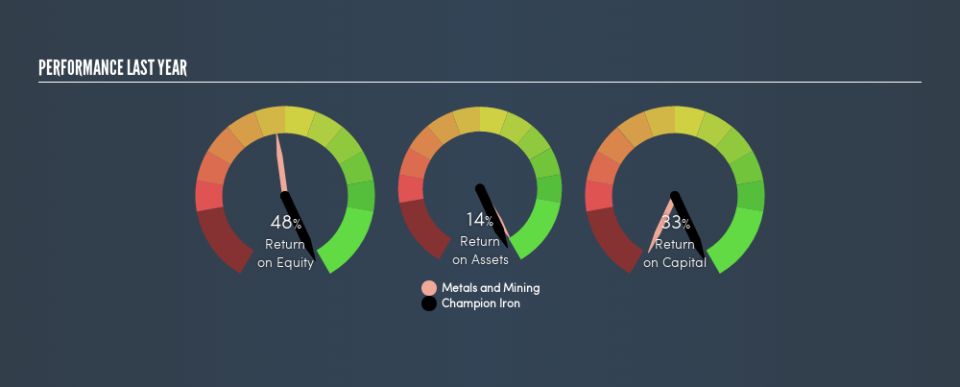Why We Like Champion Iron Limited’s (ASX:CIA) 33% Return On Capital Employed

Today we are going to look at Champion Iron Limited (ASX:CIA) to see whether it might be an attractive investment prospect. In particular, we’ll consider its Return On Capital Employed (ROCE), as that can give us insight into how profitably the company is able to employ capital in its business.
First, we’ll go over how we calculate ROCE. Second, we’ll look at its ROCE compared to similar companies. Last but not least, we’ll look at what impact its current liabilities have on its ROCE.
Return On Capital Employed (ROCE): What is it?
ROCE measures the amount of pre-tax profits a company can generate from the capital employed in its business. In general, businesses with a higher ROCE are usually better quality. In brief, it is a useful tool, but it is not without drawbacks. Renowned investment researcher Michael Mauboussin has suggested that a high ROCE can indicate that ‘one dollar invested in the company generates value of more than one dollar’.
So, How Do We Calculate ROCE?
Analysts use this formula to calculate return on capital employed:
Return on Capital Employed = Earnings Before Interest and Tax (EBIT) ÷ (Total Assets – Current Liabilities)
Or for Champion Iron:
0.33 = -CA$85.6m ÷ (CA$617m – CA$134m) (Based on the trailing twelve months to December 2018.)
Therefore, Champion Iron has an ROCE of 33%.
View our latest analysis for Champion Iron
Is Champion Iron’s ROCE Good?
ROCE can be useful when making comparisons, such as between similar companies. Champion Iron’s ROCE appears to be substantially greater than the 11% average in the Metals and Mining industry. We would consider this a positive, as it suggests it is using capital more effectively than other similar companies. Regardless of the industry comparison, in absolute terms, Champion Iron’s ROCE currently appears to be excellent.
Champion Iron reported an ROCE of 33% — better than 3 years ago, when the company didn’t make a profit. This makes us wonder if the company is improving.
When considering ROCE, bear in mind that it reflects the past and does not necessarily predict the future. ROCE can be deceptive for cyclical businesses, as returns can look incredible in boom times, and terribly low in downturns. This is because ROCE only looks at one year, instead of considering returns across a whole cycle. Given the industry it operates in, Champion Iron could be considered cyclical. What happens in the future is pretty important for investors, so we have prepared a free report on analyst forecasts for Champion Iron.
Do Champion Iron’s Current Liabilities Skew Its ROCE?
Liabilities, such as supplier bills and bank overdrafts, are referred to as current liabilities if they need to be paid within 12 months. Due to the way the ROCE equation works, having large bills due in the near term can make it look as though a company has less capital employed, and thus a higher ROCE than usual. To check the impact of this, we calculate if a company has high current liabilities relative to its total assets.
Champion Iron has total liabilities of CA$134m and total assets of CA$617m. As a result, its current liabilities are equal to approximately 22% of its total assets. The fairly low level of current liabilities won’t have much impact on the already great ROCE.
What We Can Learn From Champion Iron’s ROCE
With low current liabilities and a high ROCE, Champion Iron could be worthy of further investigation. But note: Champion Iron may not be the best stock to buy. So take a peek at this free list of interesting companies with strong recent earnings growth (and a P/E ratio below 20).
For those who like to find winning investments this free list of growing companies with recent insider purchasing, could be just the ticket.
We aim to bring you long-term focused research analysis driven by fundamental data. Note that our analysis may not factor in the latest price-sensitive company announcements or qualitative material.
If you spot an error that warrants correction, please contact the editor at editorial-team@simplywallst.com. This article by Simply Wall St is general in nature. It does not constitute a recommendation to buy or sell any stock, and does not take account of your objectives, or your financial situation. Simply Wall St has no position in the stocks mentioned. Thank you for reading.

 Yahoo Finance
Yahoo Finance 
